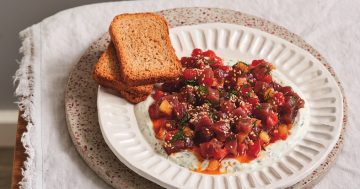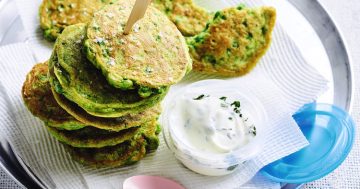By Christine Salins.
 Paon is the Balinese word for kitchen, and for Balinese food writer Tjok Maya Kerthyasa, the paon is her spiritual haven.
Paon is the Balinese word for kitchen, and for Balinese food writer Tjok Maya Kerthyasa, the paon is her spiritual haven.
“Through cooking and eating, I’ve been drawn closer to the rhythm of the island,” she says in the introduction to her book, Paon: Real Balinese Cooking (Hardie Grant Books, $50).
“It’s helped me decode the culture, become more respectful of the landscape and understand the importance of presence, process and purpose – not only behind the pans, but also across many other areas of my life.
“It’s also driven me to record and share the real flavours of Bali, the stuff beyond the eateries, beach bars and hotel kitchens – the dishes most people don’t see.”
Indonesian-Australian Maya spent nearly a decade in Sydney where she wrote for Gourmet Traveller magazine, before moving home to Bali to reconnect with her family and her birthplace.
Now living in Ubud, she began documenting her grandmother’s recipes to share with the next generation of Balinese cooks and other food lovers. On a mission to see the cuisine celebrated on a global level, and with her work drying up during Covid, she joined forces with local chef, Wayan Kresna Yasa, to produce this monumental work.
They collected family heirloom recipes from their own kitchens, as well as recipes from night markets, temple kitchens, farms and warungs (local eateries).
The result is pure joy for anyone who wants to appreciate Balinese food on a deeper level, or even just recreate some of the dishes they’ve experienced as a visitor.
Alongside the recipes are essays and beautiful photography capturing the life, culture and food from across the island, with insight into food and worship, sacred fare, and zero-waste cooking.
With dishes ranging from elaborate ceremonial cuisine such as Bebek Betutu (Ubud-style smoked duck) to dishes that rely on simple ingredients such as Be Panggang (grilled spiced snapper), it’s a real feast for the senses.
The simple tempe (or tempeh) recipe here is a testament to the magic that can happen when garlic, red (Asian) shallots, tomatoes and coconut oil join forces.
“It works nicely on its own with steamed rice or as a side in a family-style spread. You could add a sliced chilli or two for extra spice, but it’s just as nice without the burn,” says Maya.
 Tempe With Tomato, Garlic And Shallots
Tempe With Tomato, Garlic And Shallots
Serves 4
100 ml coconut oil
110 g plain soybean tempe, cut into 2 cm cubes or triangles
2 garlic cloves, finely sliced
1 red (Asian) shallot, finely sliced
2 to 3 tabasco chillies, finely sliced (optional)
2 tomatoes, sliced
1 teaspoon sea salt
6 spring onions, diced
Heat the coconut oil in a wok over a high heat. Carefully add the tempe and fry it for 2 minutes on each side, or until golden-brown and with crisp edges.
Remove the tempe from the wok using a spider ladle or slotted spoon and place it on a plate lined with paper towel to soak up any excess oil.
Using the same wok and oil, add the garlic, shallot and chilli, if using, and fry for 20 seconds, or until caramelised. Add the tomatoes and salt and cook, stirring, for about 2 minutes, or until the tomatoes have released their juices.
Add the tempe back into the wok and stir well. Add the spring onion and stir again. Cook for 2 minutes and transfer everything, oil and all, into a bowl. Serve immediately.
Recipe and image from Paon: Real Balinese Cooking by Tjok Maya Kerthyasa and I Wayan Kresna Yasa, published by Hardie Grant Books, RRP $50, available in-stores nationally.
Photography credit: Martin Westlake.






